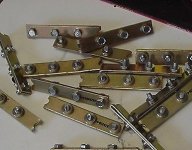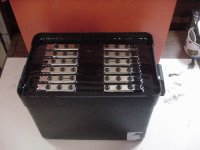macribs said:
There are a few people here in ES with more then 1200 cycle on Lipo batteries. From memory they build there battery pack with much more capacity then actually needed. And was careful charging and draining cells. If you stay away from hard usage, and dont have prolonged WOT sessions that pulls A close to max that will increase lifespan for pack. The same goes for cut off voltage. Don't discharge to minimum, stop before. And I guess hvc also set to cut off around 85% -90%.
Depending on your riding style and battery TLC you should without any problems at least the 2-3 times the lifespan of Lipo compared to your one year cycle today. Adding more weight by LTO will impact your ride, handling and even your consumption.
Getting motorcycle tires and rims will be a huge difference. You can put a Hookworm to an early grave within a month of hard use. Motorcycle tires are build to last even when used in high torque setting.
The issue with building a pack with much more capacity than needed is that you end up with much more weight - of course - and that's the point here. In fact, I would say that you actually do need it, not for energy capacity but for power capacity.
That's what is great about LTO. What it lacks in specific energy it makes up in specific power

It all depends on your requirements.
So I thought I'd put down a detailed analysis for my application - and please tell me if I'm missed anything.
Here are my Requirements:
72V Nominal
60 A Cont /100A peak.
> 10Ah for commute.
Consider these 4 potentialy viable options that meet these requirements on paper.
Value LIPO: Multistar
For my power requirement I would need at least 30Ah (3C)
That's 3 x 5 x 4S 10 ah pack at ~$50 each = ~$750 (on sale now usually ~$65 or ~$1000 per pack)
Weight is 15x800g = 12kg or
26.4 lbs <- heaviest
In theory as you say, if I use it nicely I could get at least 1000 cycles (11Ah per cycle) before I get too much sag at 100A, although in practice it seems to be much less - see PS.
That's 16000 miles per pack or
$0.0460 per day.
Quality LIPO: 65C Graphene
For my energy requirement I would need 10Ah (that would be cutting it close - I would probably go with 15Ah, but I'll use 10Ah)
That's 2 x 4 x 5S 5 ah pack at ~$100 each = ~$800
Weight is 8x750g = 6kg or
13 lbs <- lightest
(15Ah would be 20lb and $1200)
Rated for 600 cycle (probably inflated).
That's 10000 miles for the 10ah battery or
$0.080 per day.
<- Most expensive
Panasonic NCR18650PF 2900mAh 10A
For my power requirement I would need 20S10P
That's 200 cells at $4 each = $800
Weight is 200 x (45.3g ) = 9kg or
20 lbs
I'll be generous and estimate 1000 charges
That's 16000 miles per pack or
$0.050 per day.
Did not include $200 welder (that I don't have) and additional considerable cost of holders and strip needed to build this type of pack.
LTO:
For my energy requirement I need 11ah cells.
That's 30 1S 11ah pack @ $9 each = $270 (great deal on Ebay, also available on Aliexpress for $15 a cell)
Weight is 30 x 340g = 10Kg or
22 lbs
According to specs I should get 5000 cycles - but I'll assume 4000 since that would be 90% or 10 Ah.
That's 64000 miles per pack or
$0.004 - $0.007 per day (depending on where you buy the LTO).
<- Cheapest
Conclusions:
For what
I need LTO is in fact comparable weight and a lot cheaper by a factor of 10X.
Panasonic is clearly a close runner up, and probably the winner for most, which is why it is so popular. I would get 3X the range! It was tempting to go that route, but was deterred by having to spot weld the pack properly with 200 cells at 100A rating and the impact on it's long term mechanical and electrical durability. Could also have bought 2X 72V 11Ah packs from Luna Cycle for $1200 but that's a bit steep both short term and long term - wise.
Added bonus 1 of LTO: I don't have to build as many pack and balance as many cells, which I know for some of us is most of the fun

Added bonus 2 of LTO: LTO can be charged outdoors in freezing weather - kinda nice not to have to carry in a 25lbs battery everyday 4 months out of the year.
Added bonus 3 of LTO: I could charge it in 20 min @ 30A - BMS limited, but will probably look at 18A (35 mins) since that's about all I can get from a 120V outlet

.
PS I have tried the 30Ah Multistar Lipo combo. At first I was using 20Ah with my 50A/60A contoller and that worked pretty well for a year until I would get sometimes LVC on the way home @8Ah. But then got a new 60A/100A controller so thought I would build a fresh 30Ah pack. Right off the bat, after 5Ah I would hit LVC on hard acceleration which is about 3C. Either need 40Ah (no way!) or probably got a bad pack although I measured each 10Ah pack and IR was 10mOhm per cell on average (compared to my one year old pack that had 20mOhm IR)... anyway I'd have to figure which specific cell was bad and that's a pain... hence why I'm looking for a sustainable/reliable solution...






